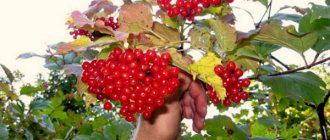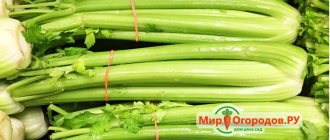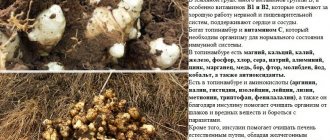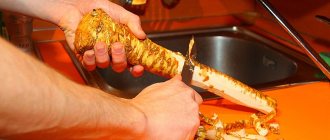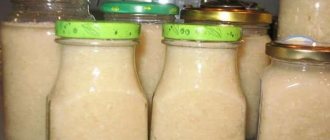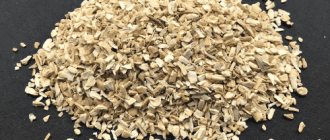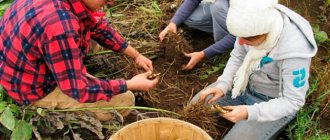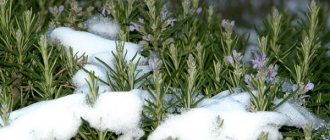Description of the plant
Before discussing the question of when to dig up horseradish, let's look at the plant itself. This vegetable is distinguished by the fact that in addition to gorgeous foliage suitable for use, it also has roots that are popular among chefs. Belongs to the Brassica family and came to us from Asia and America. Specific taste properties and a special aroma have made it one of the most popular in our gardens. Likes to grow in places with high humidity. The plant has a wide range of beneficial properties, including medical ones. Having pronounced antibacterial qualities, it is successfully used in folk medicinal recipes.
When to dig up horseradish
When talking about the ideal time to dig up a plant, there are two different periods:
- The first period when digging up horseradish root is allowed without compromising its taste is the very beginning of spring. When the snow has melted and the young shoots have not yet begun to grow, you need to dig it up for future use. This is mainly done during this period for transplantation and reproduction.
- The second time period when it is best to dig up horseradish is considered to be late autumn. It is at this time that it is collected for storage for the winter. A sign that you can start collecting root vegetables are dried leaves that lie completely on the ground.
The entire harvesting process comes down to the following manipulations:
- we prepare a tool suitable for this process (this can be either a special “Kolesov sword” used for working with root crops and seedlings, or a pitchfork, provided that the soil is soft);
- carefully dig the entire plant out of the ground, without tearing off the leaves;
- We cut off the leaves so that a stem about two centimeters long remains at the root (this is necessary for organizing further storage of the roots).
Horseradish storage
It’s not enough to know when you can dig up horseradish. A competent gardener must thoroughly prepare for the proper storage of the crop. We list several options for organizing such a process:
- Cellar. Most often, this is where most owners store this vegetable. But this must be done carefully. The air temperature in the cellar should be around 0. +2 degrees with a humidity of 80 percent. You can use a hole in which horseradish is placed, adding sand or peat to each layer. The latter prevents mold from spreading. Storage in plastic bags is also allowed, but not thin ones. They should keep the temperature and humidity inside well. For such storage, the roots must be washed, dried, and after putting them into bags, inflate them until they are completely filled. It must be sealed tightly.
- Powder. Some people prefer to store horseradish in powder form. To do this, the plant needs to be washed, dried, cut into thin strips and placed in the oven to dry at a temperature of 50 degrees. After this, grind the root vegetable into powder and store it in jars.
- Fridge. If you plan to store the vegetable for a short period of time, you can do this in the refrigerator. Wash the roots, sort them, put them in a bag. Seal tightly and place in the refrigerator. The root vegetable will be at your fingertips for a relatively long time, but no more than three months.
- Vinegar. If you grate the root and add vinegar, this mixture can also be stored in the refrigerator. The flavor of horseradish is retained and can be used in culinary recipes.
How to store horseradish so it doesn't spoil
Storage technology is very important to preserve all the valuable properties of the product. Horseradish does well in cool and dark rooms. The dug up rhizomes can be placed in boxes, covered with sand and lowered into the cellar. They can also be stored in a similar container on the balcony, but the temperature should not fall below 0 degrees. If the balcony is not insulated for the winter, you should think about preventing the product from freezing.
There is no need to clean the roots before storing them. It is also not recommended to wash them. But before storing them in the cellar, it is worth drying the rhizomes well and sorting out all rotten, damaged specimens.
You can store the roots in the refrigerator for up to 3 months. But first they must be washed and placed in a plastic bag. This product would be best placed on the bottom shelf. Temperature differences there are less significant.
Application of root vegetables
It is impossible to list all the uses of this amazing plant. The main feature of its use in cooking is that it cannot be hot processed. When boiled and stewed, horseradish completely loses its specific taste and aroma. If you want to use the grated product, then do not forget to immediately close the container with a lid so that the horseradish does not lose its culinary appeal.
As a medicinal plant, it is used in a variety of medicines, either alone or in combination with other products. Ascorbic acid, vitamin B, microelements and organic compounds are not the entire list of useful elements that make up horseradish. It is used to normalize metabolism, stimulate the gastrointestinal tract, relieve joint pain, etc.
Important information
It is important to remember that before harvesting, you need to make sure that the plant is not susceptible to any disease and has not become a victim of pest attack. Otherwise, you risk leaving non-root vegetables for storage, which can be harmful to health.
The spicy plant horseradish grows in almost every garden plot. Leaves and roots are used in medicine and in cooking for various dishes and preparations. To get a harvest of juicy roots and leaves, you need to know how and when to dig up horseradish.
Horseradish is dug up when the leaves begin to turn yellow.
How to get a good harvest
The quality of the harvested crop, its beneficial properties and shelf life depend on the growing conditions of this crop.
- Horseradish likes to grow in light, loose soil with a slightly acidic reaction and fertilized with organic matter and minerals.
- The location is chosen in partial shade with deep groundwater. The best predecessors are legumes and grains.
- The crop is grown from roots cut into segments no less than 20 cm long and no more than 2 cm thick. Each root should have three eyes at the top for foliage development, and the same number at the bottom for root branching.
- To protect against diseases, before planting, planting material is dipped in a solution of potassium permanganate. After which it is poured into prepared planting holes according to the size of the roots.
- The crop can be planted in spring or autumn. Regardless of the planting period, the cold-resistant plant takes root well. Follow the pattern - 30x40 cm. Plant at an angle of 45° until the eyes are completely submerged in the lower part.
- Basic care consists of moderate but frequent watering, loosening, fertilizing twice a season with ammonium nitrate (at the beginning of the growing season) and superphosphate with potassium (in mid-summer). All fertilizing is combined with watering.
- Preventative treatments against parasites will help protect the integrity and taste of leaves and roots. The bushes are irrigated twice - in early spring and early summer with a solution of copper sulfate or Bordeaux mixture.
To dig up root crops, use strong plants that are not affected by rot, mold, or various parasites. This way you can get not only a tasty and spicy, but also a healthy product.
Cleaning time
There are two periods when you can dig up horseradish.
- You can harvest root crops without loss of marketability and taste in the spring. You need to dig it up immediately after the snow thaws, but the shoots will not begin to grow. This harvesting method is often combined with transplanting the bush to a new location or dividing it into several parts for the purpose of propagation.
- The second period for digging up root crops is late autumn. During this period, horseradish ripens well, and after digging it can be stored all winter in a cool place. A sign that the plant is ready for harvest is drooping and yellowed lower leaves on the bush.
Harvest dates in 2021
Many people are interested in when to dig and collect horseradish so that it is evil. The rhizomes are the sharpest in the spring, but autumn harvesting is preferable due to its richer vitamin and mineral composition. The question of when to dig up horseradish for harvesting for the winter, in what month, is also relevant. Here, not only experienced gardeners, but also astrologers can give advice.
It is better to plan the harvest according to the Moon. In one cycle it goes through several phases: new moon, waxing, full moon, waning. The most unfavorable days are the days of the new moon and full moon. Most often there are 2 such dates per month. It’s better not to plan anything at this time, reschedule work for another day.
On the waning Moon, harvesting is considered the most favorable. During this period, sap flow slows down, reducing the risk of rhizomes rotting after digging. Horseradish harvest dates for autumn 2021 are shown in the table:
| Month/Moon Condition | Favorable days (waning moon) | Unfavorable days (waxing Moon) | Forbidden days (new moon, full moon) |
| September | 1-6, 22-30 | 8-20 | 7, 21 |
| October | 1-5, 21-31 | 7-19 | 6, 20 |
| November | 1-4, 20-30 | 6-18 | 5, 19 |
On a note!
If the root is needed only for adding to dishes, for short-term storage, you can dig it up during the waxing Moon. In such cases, you can ignore the recommendations of astrologers.
Useful tips
Now about how to dig up horseradish. The whole process consists of several manipulations.
- for harvesting you need to choose a suitable tool - you can dig horseradish with a shovel, a pitchfork or a special Kolesov sword, designed for collecting root vegetables;
- plants are dug up together with a lump of earth without removing foliage;
- then all the leaves are cut off with pruning shears or any other sharp object, leaving small stems 2-3 cm long so that the roots can be preserved longer.
You need to harvest the crop a couple of hours after drying in the fresh air.
Storage methods
We figured out how and when to dig horseradish root, now we’ll talk about how to preserve it correctly and longer without losing its original taste and beneficial properties.
Basement or cellar
Typically, gardeners store their crops in a basement or cellar. It is important to create the necessary conditions - a temperature of 1-2°C and humidity within 75-80%.
You can store it in a hole, laying the roots in stacks and sprinkling each layer with sand. This way the crop will be protected from mold.
Some are stored in thick plastic bags in which the required temperature and humidity are maintained. Before placing them in bags, the roots are washed, dried thoroughly, then laid and tied tightly.
You can store the harvest in the basement or cellar until spring.
Fridge
The method is suitable for crops that are planned to be processed in the near future or used for cooking.
The roots are sorted out, not washed, all damaged areas are removed, and cut into segments of the required length. Then put it in a plastic bag, tie it tightly and place it in the vegetable storage compartment. In such a place, the harvest will last no more than three months.
You can store this product in the refrigerator in vinegar. First, the roots are harvested - washed, peeled, and ground on a grater or blender. Transfer to a glass container, fill completely with vinegar, seal and place in the refrigerator. This product does not lose its taste for about six months.
Storing horseradish in vinegar
In crushed form
The root vegetable is washed, dried, peeled, then cut into thin slices. Lay out on the surface of a baking sheet and dry at a temperature of 50°C. The dried roots are ground into a powdery mass, poured into sealed glass jars and placed in a dry and warm place for storage. Shelf life - until the next harvest.
How to store horseradish for the winter in the refrigerator
Conventional storage of the root vegetable, twisted in a convenient way at home, will help preserve the sharpness of grated horseradish for a long time. You can preserve the freshness and benefits of the root for a long time if you make seasonings based on the plant or store the grated horseradish in its pure form in the freezer.
From the frozen root at home you can prepare savory dishes, savory snacks, hot seasonings, hot sauces using the classic recipe with fresh horseradish.
Frozen root, horseradish, which has been frozen in the freezer for a long time, releases fewer phytocides (fewer tears from working with the roots), but retains its beneficial and pungent properties.
This preservation is often compared to another popular hot sauce - adjika. But preparing it is much easier and faster.
What you will need:
- ripe tomatoes - one kilogram;
- head of garlic;
- horseradish root vegetables - one hundred grams;
- vinegar solution - thirty milliliters;
- salt – one tablespoon;
- sugar - one tablespoon.
- The peeled horseradish root is crushed. Garlic is ground in a mortar. Peeled tomatoes are pureed using a blender.
- All vegetables are mixed, salted, sugar and citrus juice are added. Place the saucepan with this mixture on the fire and bring to a boil.
- Fill sterile containers with the hot mixture and seal tightly with lids.
How to store horseradish at home if you don’t have a cellar:
- If there is a balcony, the technology of laying in sand is used on the balcony.
- To prevent severe frost from spoiling the harvest, cover the container with roots with a blanket or felt.
Application
Further use of horseradish root excludes heat treatment, since in the process it will lose its piquant taste and pungency.
It is added to various dressings and sauces for all types of meat and fish. Also served with tongue, jellied meat and various appetizers.
Preparing horseradish for drying
This product is an excellent preventative against colds, viral, fungal and bacterial infections. With regular and moderate consumption, horseradish increases immunity in the off-season, improves appetite and normalizes the functioning of the digestive system. It is also recommended to consume root vegetables as a remedy against cancer.
Root-based lotions eliminate joint pain, help with rheumatism and treat fungal skin infections.
The question of when to dig up horseradish in order to be ready for storage at first glance seems simple. But the answer, as practice shows, is not entirely unambiguous, or rather, it has two meanings - you can dig it in spring and autumn. Moreover, in each case, from the same area, and even from a number of growing bushes, the root turns out to be completely different, bitter and pungent in the spring and, oddly enough, a juicy and sweetish-spicy root in the fall. And there are several explanations here.
The benefits and harms of root vegetables
Horseradish is considered one of the most useful plants. The root and leaves contain alkaloid and bactericidal substances, mainly lysozyme. It is a powerful bactericide and fungicide. The rhizomes also contain a huge amount of vitamins.
Horseradish has powerful antibacterial properties that can fight even the most severe forms of infection. It contains calcium and magnesium. The crushed root helps cure many eating disorders, improves appetite, and normalizes blood pressure.
However, overuse of this spice is harmful. Frequent consumption may result in vomiting and diarrhea. The substances contained in this product suppress the activity of the thyroid gland. Horseradish is not recommended for pregnant women and nursing mothers.
You can dig horseradish both in spring and autumn. At the same time, preparations made before winter will be more juicy. In 2021, every autumn month has favorable days for harvesting rhizomes. The time frame for harvesting horseradish is quite extended, so you can choose a convenient time for yourself. Yellowing of the aerial parts indicates that the horseradish is ready to be harvested.
Features of growing crops
The plant, which can be found in every area where there are vegetable beds, turns out to be not so simple and has its own characteristics of growing, saving and preparing. The wide distribution of horseradish is associated with its taste. Without horseradish leaves, it is impossible to preserve crispy cucumbers and spicy tomatoes, and as a spicy seasoning, not a single feast can do without it.
But as for growing and cultivating, this plant has its own special character, it’s not for nothing that it was called horseradish. The optimal place for growing the crop is light soils with moderate or weak acidity. The quality of the root can be judged by the foliage - abundant, deep green foliage with a stiff central stem indicates that this is a great place. Where there are enough minerals and organic fertilizers, but the main thing is the deep occurrence of groundwater.
Various techniques are used as agricultural technology, for example, planting with roots. Under normal conditions, the crop can be dug in the fall, and after 1-2 seasons you will simply have to deal with the rhizome throughout the entire area. This plant also loves timely feeding, especially the application of organic fertilizers in the fall. Alternation with other crops, for example, legumes, also has a beneficial effect. But as for planting, there is not much difference whether to plant horseradish in autumn or spring.
How horseradish grows
Alas, the plant, like other garden crops, is susceptible to diseases and often becomes a victim of pests. That is why it needs timely care and treatment with chemical and biological means of protection. A simple but effective method of prevention is to irrigate the foliage with copper sulfate or Bordeaux mixture. Treatment time is in the spring after the foliage opens and in the fall 2-3 weeks before harvest.
In terms of agrotechnical measures, horseradish requires timely weeding and removal of wilted leaves; it is the foliage affected by pests that causes damage to the rhizome. The planting pattern is row with an interval of 30-40 cm in a row and up to 40 cm in row spacing.
Recipes for harvesting horseradish roots for the winter with additional ingredients
True gourmets will appreciate horseradish preparations with lemon, apples or mayonnaise. They have a rich flavor while retaining all or most of the sharpness of the roots. And if you add spices to the sauce, you get a whole bouquet of flavors.
Horseradish recipe for the winter with lemon and spices
This seasoning will not leave anyone indifferent. The triple composition of various spices combines perfectly with the sharp aroma of horseradish, complementing it perfectly. And lemon juice will also add a pleasant sourness.
For preparation you will need:
- horseradish in the amount of 1 kg;
- 1 tbsp. l. salt and sugar;
- 1 lemon;
- ground nutmeg and cinnamon – 1/3 tsp;
- 3 buds of cloves;
- ¼ tsp. mustard seeds.
First you need to peel the roots and leave them to soak in cold water for half an hour. After the specified time has passed, you can begin harvesting horseradish roots for the winter:
- Peel the roots and chop them in any way (through a meat grinder or on a grater).
- Squeeze juice from lemon.
- Prepare the marinade by bringing water and seasonings to a boil. At the end add lemon juice.
- When the marinade has cooled a little, strain it and pour into the chopped roots.
- Mix the mixture well and pour into jars.
- Sterilize for 20 minutes.
- Roll up.
Horseradish with lemon zest
Another recipe for an original horseradish-lemon snack will bring double the benefits. It can be used as a seasoning for fish dishes, and can also be used to prevent colds. As usual, the roots are washed, soaked, peeled and chopped. Separately, you need to squeeze the juice from a large lemon, and grate the zest into a plate on a fine grater.
Now mix the grated horseradish with salt and sugar (1 tablespoon of each product). Then pour all the zest into it, and also pour 1 tbsp. boiled but cooled water. Mix all ingredients and place the mixture in jars. Before rolling into each container (from above, without stirring), pour a little, about 1 tsp. freshly squeezed lemon juice.
The amount of horseradish per serving is 1 kg in peeled form. There is no need to sterilize this seasoning in order to preserve maximum nutrients.
Recipe for horseradish with apples for the winter
A sauce made from horseradish and sour apples goes well with cold meat dishes. It turns out to be sour, but with a well-defined spicy note. However, the amount of ingredients can be changed depending on taste preferences. If you use sweet fruits, then the sauce will be sweeter and softer. And to get a spicy seasoning, you need to add more horseradish and garlic.
So, for one serving of sauce you will need:
- 2 kg apples;
- 100 g each of horseradish and garlic;
- sugar, salt (to taste).
A horseradish appetizer with apples is made like this:
- Apples need to be cored and grated. If the skin is too hard, you can cut it off too.
- Pass the pre-soaked and peeled roots through a meat grinder along with the garlic.
- Mix both ingredients, add salt and sugar.
- Boil the workpiece over low heat for 5 minutes, put it in jars and roll it up.
This sauce is stored in the refrigerator. And to make it last longer without it, during the cooking process you need to add 1 tsp. table vinegar.
The sauce for this raw horseradish recipe for the winter is also very tasty. In this version, it is not boiled, but only the apples are pre-baked. Horseradish and garlic remain raw. For winter storage, be sure to add vinegar.
Horseradish with mayonnaise for the winter
A spicy seasoning can be not only spicy, but also satisfying. Mayonnaise will help add some calories to horseradish sauce. The only drawback of this preparation is that it is not quite “winter”. Of course, well-sealed jars will last in the refrigerator for some time. However, mayonnaise significantly reduces shelf life, although it makes the sauce tasty.
These horseradish roots are quickly prepared for the winter as follows:
- Wash, soak, peel and grate 200 g of roots.
- Add mayonnaise to them (preferably in an amount exceeding 2 times horseradish, that is, 400 g).
- Put a little salt (considering that mayonnaise itself contains a fair amount of it) and 1 tbsp. l. Sahara.
- Pour in 1.5 tbsp. l. vinegar.
- Mix the mixture, place in jars and seal tightly.
As already mentioned, horseradish mayonnaise sauce should be stored in the refrigerator.
To make the seasoning as low in calories and healthy as possible, it is better to use homemade mayonnaise.
To do this, break 1 egg into a submersible blender (so that the yolk remains intact), add a little salt, add 1 tsp. sugar, vinegar and mustard. Lastly, pour in 200 ml of refined sunflower oil. Now you need to cover the yolk with a blender and beat until a thick white mass, gradually lifting the blender and adding oil.
Now you know what you can do with horseradish for the winter. We hope that among this selection there will be a recipe for your family that you can surprise your loved ones and guests with. Have fun cooking and add variety to your winter menu!
You may also find the following materials useful:
- Garden treatment in autumn 2021: what to treat, the best and most effective means
- Lunar calendar for indoor plants for September 2021: favorable days
- Planting winter garlic in the fall of 2021: a guide for beginners and more
- Favorable days for planting strawberries in September 2021 according to the lunar calendar
- When to salt cabbage in September 2021 according to the lunar calendar
Timing and features of harvesting
The uniqueness of this root crop is that the timing of digging up horseradish depends on the purpose for which the root crop will be used. A good time for harvesting is in the fall. This is the time when horseradish is being prepared for the winter. As with other root crops, it is fashionable to determine readiness for harvesting by the foliage. Yellowed foliage indicates that you can dig. At this point, the root has collected the maximum amount of juice, in which the sugar level reaches the limit.
Harvesting is carried out with a deeply driven shovel. Before removing the root, you need to dig it up from all sides. In this case, the upper part of the rhizome breaks off deeply, which makes it possible to obtain an excellent product for harvesting for the winter and at the same time leave a reserve in the soil for growth for the next season. Dig out the horseradish with a sharply sharpened bayonet shovel with a long handle. If you dig under the bush incorrectly, or pull it by the leaves, the root will simply remain in the ground. The plant is turned out together with the lump of earth and only after that is cleared of soil and foliage.
For making seasonings and sauces, the best time to dig up horseradish is usually in early spring. They also dig up horseradish, digging deep under the bush, but the taste in it in the spring is completely different. The amount of sugar in the juice decreases, but it is saturated with unsurpassed aroma and bitterness.
For summer preparations, horseradish is dug up from mid-July
For summer harvesting and preservation, horseradish is dug up starting in mid-July. For these purposes, the root, dug up plant and young leaves are used. Select and dig up a plant with wide, large leaves that are a deep dried green color. Do not pay attention to bushes with yellowed foliage and weak leaves.
As for the weather, it is believed that the best time to dig up horseradish is dry and sunny weather for 4-5 days. By this point, the root has time to shed excess moisture, and the soil has time to dry out.
What horseradish preparations to make for the winter
You can make a lot of tasty and healthy preparations from horseradish, which are then used as an addition to dishes. The classic recipe for the preparation involves chopping peeled rhizomes in a meat grinder or blender, adding sugar, salt, and water. For 250 g of chopped roots you will need 150 g of water, 1 tsp. salt, 1 tbsp. l. Sahara. In this case, it is better to dissolve sugar and salt in water in advance, pour the solution into chopped horseradish, placed in sterile jars.
A very popular snack is called horseradish. It is prepared with the addition of tomatoes. For 3 kg of tomatoes you will need 300 g of chopped horseradish, 2 tbsp. l salt, 50 g garlic. Peel the tomatoes, remove the stems, grind in a meat grinder along with peeled garlic, combine with horseradish, add salt and place in sterile jars.
You can also prepare snacks with sterilization, but when heated, some of the valuable substances contained in the rhizomes are destroyed. Therefore, the most useful are the blanks that are made without the use of heat treatment. If you have doubts that the product will stand for the required amount of time, you can add a little vinegar.
Storage methods
The preparation of sauces and seasonings is usually done from the fresh root. When the root is dug up, it is allowed to dry for 2-3 hours and after that they begin storing or processing.
To ensure that the product does not lose its taste and presentation during storage, two basic conditions must be ensured - humidity and temperature.
In a basement, cellar or temporary earthen pit, storage should be carried out at a temperature of +1-3 degrees. Humidity should be within 75-85%.
Winter is not the best time of year for open storage, but horseradish can also be stored in a dugout, especially when it comes to planting material. To do this, a hole up to 1.5 meters deep is dug. The bottom is covered with a layer of straw, then a stack with roots, sprinkled with sand, is arranged on a sheet of cardboard. The top of the stack is again covered with a layer of straw. At ground level, a pipe is installed to remove air and an earthen embankment is made. Polyethylene is used as a shelter from moisture, but it should not cover the pipe. The edges of the polyethylene should extend 0.5 meters beyond the pit.
The roots should be stored in an airtight container in the refrigerator. Horseradish should not be stored openly in refrigerators with an air-flow function. This will simply dry out the roots.
Preparing horseradish for the winter without additives
Not everyone likes when the characteristic horseradish aroma and spiciness are dissolved in the taste of additional ingredients. For example, if you add apples to the roots, they soften their heat. This makes the sauce more pleasant and weaker. If you are one of the ardent fans of strong seasonings, simply do not add anything to the roots. Then the horseradish will turn out to be real and evil.
Interesting: Is it possible to dry mushrooms in the refrigerator?
Recipe for horseradish for the winter with vinegar
Before you start cooking, 1 kg of roots must be thoroughly washed from the soil and left in water for a day. On the second day, soaked horseradish can be peeled by scraping the skin, like a young carrot. The preparation process itself is simple:
- Grate horseradish.
- Place in a bowl and fill with brine.
To prepare horseradish brine:
- boil 250 ml of water;
- add 1 tbsp. l. salt and sugar;
- at the end pour in 150 ml of vinegar (9%).
Pour the cooled brine over the grated roots, mix and place in jars. This seasoning is stored in the refrigerator. The maximum time is no more than 4 months. The purpose of preparing horseradish at home for the winter is often a longer shelf life. You can increase it by additionally sterilizing the jars of sauce for 20 minutes.
The jars must be glass, with a well-screwed lid - in such containers, horseradish better retains its aroma and “strength”. They also need to be sterilized first and allowed to dry.
Quick horseradish seasoning recipe
And not all housewives like to tinker with jars, subjecting their contents to additional heat treatment. On the one hand, this increases the shelf life of preservation and makes it more reliable in this regard. But at the same time, this is an additional time investment. The aromatic root vegetable is one of those from which you can make horseradish preparations for the winter without sterilization. This has its advantages too. Such products can be stored for several months, although it is best in the refrigerator, but the characteristic pungent smell and pungency are completely preserved. In addition, “raw” horseradish also retains the maximum amount of nutrients, especially if you use citric acid instead of vinegar.
